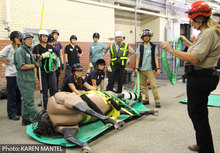A respected authority in large animal handling techniques brought her expertise to the Ontario Veterinary College's Large Animal Hospital in early June.

Practice in rescuing horses
Gimenez customized her course offering, providing hands-on opportunities with equine models using a variety of large animal techniques, tactics, and procedures to safely move and handle animals.
© 2016 by Karen Mantel
More than 50 staff, registered veterinary technicians, clinicians, interns and residents from the UofG's OVC joined a half-day Technical Large Animal Emergency Rescue (TLAER) course with Dr. Rebecca Gimenez, focusing on safe transfer and handling of large animals.
"She shared some great knowledge and experience with us that will help us provide more efficient and safer patient care - not only safer for the patient but also safer for our employees," says Amy Richardson, Supervisor, Patient Care and Service Delivery in OVC's Health Sciences Center.
Gimenez customized her TLAER course offering for the OVC session, providing hands-on opportunities with equine models using a variety of large animal techniques, tactics, and procedures to safely move and handle animals.
Participants practiced assembling halters from ropes and straps, perfected using a sideways drag and roll to position a horse onto a glide, and worked as a team to set up an Anderson sling in the Large Animal Hospital. Anderson slings can be used in multiple scenarios to lift a large animal or to elevate an injured animal and relieve pressure on its limbs.
Participants also tackled emergency scenarios, rescuing an injured horse model from a trailer, first stabilizing the patient and then working together to safely move the animal out of the trailer using a glide.
Based in Georgia, Gimenez developed the TLAER training in the mid-1990s with Dr. Tomas Gimenez. She has travelled extensively training first responders, veterinarians and veterinary technicians in these techniques.
Key to every scenario is safety "for self, team and the animal," says Gimenez. Positioning is vital with horses to stay clear of the head and kick zone of the legs. She advocates assigning one individual as the incident commander during rescue operations or emergencies and another to focus solely on safety. She is also a strong advocate for helmets and gloves when working with horses.
Planning is also vital in an emergency situation. An 'aha' moment during the training for Carina Cooper, a large animal internal medicine resident, was the reminder that an emergency situation may have been happening for hours.
"Take the time to come up with a good plan and equipment. A best laid plan is worth way more than rash decisions."
While the rescue training focuses on emergency situations, techniques are applicable to day-to-day work with animals.
"It's easier to do these things in a clinical situation where you have lots of people and all the equipment you need, but you're trying to prepare the veterinarian and the veterinary technician for a situation where there is only one or two of them and they need to be able to use mechanical advantages or tools that will make their job easier and safer," she adds.
"It was an excellent course and good refresher for what we do here," says Andrew McHitchison, who provides clinical support in the OVC HSC. "Rebecca is a fantastic speaker."
Many of the tips Gimenez suggested were straightforward, adds Richardson, how to position proper ropes or straps for forward assists, backward assists, and how to make rope halters.
"Sometimes you may have a horse that either doesn't have a halter or doesn't have one that fits properly so we can fabricate one quickly and simply from cotton rope which we have in stock," adds Richardson.
"Maneuvering in a trailer, how to use the sling in an efficient manner, using straps to move a horse into a sternal position, and even hospital or stall design recommendations to make your life easier when handling or moving animals were all helpful tips for in-hospital cases," adds Cooper.
First responders from Adjala-Tosorontio, Guelph/Eramosa, and Erin Fire Departments, with previous TLAER training through Equine Guelph also assisted with the workshop.
"We are so pleased to have this opportunity to facilitate bringing this training to the large animal clinic. There are so many professional groups that benefit from this level of expertise for safety and welfare of both animals and people involved. We are committed in our ongoing efforts for this program and look forward to future training offerings," says Dr. Susan Raymond, Communications and Programs Officer, Equine Guelph.
"Rebecca was quite pleased with our facilities and to see a lot of the equipment that we have in place to help us do a better job and to make things safer for all of us," adds Richardson. The training offered hospital personnel a chance to ask questions and "learn from one of the best in the world."
The training was sponsored by Merial, the Ontario Equestrian Federation and Equine Guelph.
Equine Guelph is the horse owners' and care givers' Centre at the University of Guelph. It is a unique partnership dedicated to the health and well-being of horses, supported and overseen by equine industry groups. Equine Guelph is the epicentre for academia, industry and government - for the good of the equine industry as a whole.
Story by: Karen Mantel
